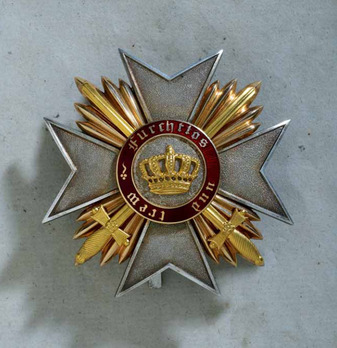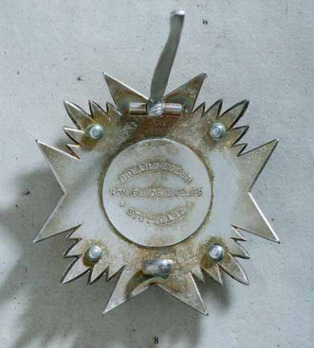Order of the Württemberg Crown, Military Division, I Class Commander Breast Star
CATEGORY: Version
SKU: 01.WUT.0104.204.01.001
Estimated market value:


Estimated market value:
A Maltese cross, constructed of silver, silver gilt, and enamel. The decoration features two crossed swords through the centre. The cross arms are pebbled and in silver, with a narrow raised edge. In between the arms are five golden rays each. The centre medallion is pebbled and in silver. It features a golden crown. The medallion ring is enamelled in crimson red with the golden inscription ‘FURCHTLOS UND TREW’ (‘fearless and loyal’). The reverse is in silver and features a vertical pinback.
On September 23, 1818, King Wilhelm I combined the Royal Order of the Golden Eagle and the Order of Civil Merit to create the Order of the Württemberg Crown. The order was awarded for chivalry. It originally consisted of three grades: Grand Cross with Grand Cross Breast Star, Commander (Komtur), and Knight.
The motto of the order was "Furchtlos und Trew" which translates to "Fearless and Faithful".
Civilians who received the order were given “Personaladel”, which means that they became members of the nobility and were given access to court. However, the individual held no actual rank and the nobility could not be passed on to their children. The system of “Personaladel” was instituted in Württemberg in 1806, and it was discontinued in 1913 due to disuse.
If an individual received an award of the order, they were required to add it to their title and coat of arms. Grand Cross recipients added the Grand Cross to a band which wrapped around their heraldic shield; Commander recipients added the Commander grade to a band which wrapped around their shield; recipients of the Knight’s Cross added the Knight’s Cross to a bow at the bottom of their shield.
The order's grades and attributes were changed multiple times throughout its history. Until 1913, the higher award grades were restricted to members of the nobility.
In 1864, Charles I of Württemberg (König Karl) determined that members of the Württemberg royal family and other reigning houses would receive a special Grand Cross Breast Star that featured black enamel. In addition, members of reigning houses wore the Grand Cross from a scarlet red band, rather than a carmine red band. The order was awarded to the princes of Württemberg after their 7th birthday, while the princesses of Württemburg became members of the order after their 14th birthday.
In 1864, the Knight's Cross with Golden Crown was added as a rank.
As of 1870, surmounting crossed swords could be added to all grades to recognise a recipient for military merit in wartime.
In 1870, the Knight’s Cross (without a surmounting crown) was divided into two separate classes, I Class Knight and II Class Knight. In 1886, the Knight’s Cross with a surmounting crown became a separate award called the Knight Honour Cross, which led to the discontinuation of the II Class Knight grade.
In 1889, the grade of I Class Commander and I Class Commander Breast Star were added to the order. The original Commander (Komtur) grade became the II Class Commander.
In 1892, the Silver Medal of Merit was abolished and the Golden Medal of Merit was added. As of 1892, the I Class Knight could be awarded with lions between the cross arms, and the Knight Honour Cross was produced with a pinback. The Grand Cross and Commander grades were always awarded with lions between the cross arms.
As of 1917, military officers who had received the Grand Cross were given permission to wear the decoration suspended from their neck.
Known manufacturers of the order grades include: F. Steinam, Stuttgart; Eduard Foehr, Stuttgart; Württemberg Royal Mint, Stuttgart; Carl Zinser, Stuttgart.
The order was abolished in 1918.
The I Class Commander and II Class Commander are identical. The only difference is that the I Class Commander was awarded with the I Class Commander Breast Star.
The I Class Commander Breast Star is one of the rarest Breast Stars from Imperial Germany.

Comments
Sign in to comment and reply.


Scroll Top